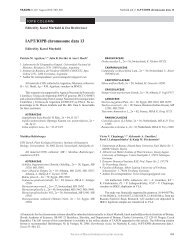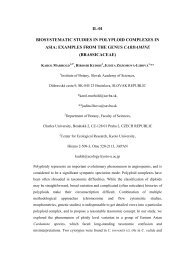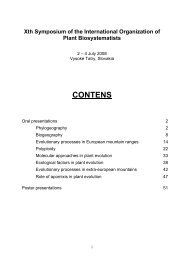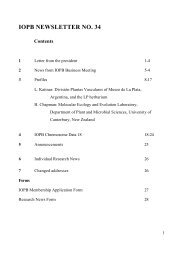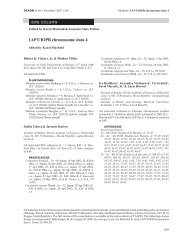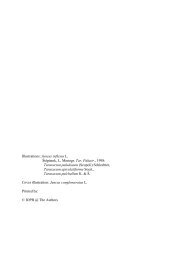IAPT/IOPB chromosome data 10 - International Organization of Plant ...
IAPT/IOPB chromosome data 10 - International Organization of Plant ...
IAPT/IOPB chromosome data 10 - International Organization of Plant ...
You also want an ePaper? Increase the reach of your titles
YUMPU automatically turns print PDFs into web optimized ePapers that Google loves.
TAXON 59 (6) • December 20<strong>10</strong>: E1–14<br />
Marhold (ed.) • <strong>IAPT</strong>/<strong>IOPB</strong> <strong>chromosome</strong> <strong>data</strong> <strong>10</strong><br />
Vladislav Kolarčik, 1 * Michal Moravčík, 1 Judita Zozomová-<br />
Lihová 2 & Pavol Mártonfi 1<br />
1 Institute <strong>of</strong> Biology and Ecology, Faculty <strong>of</strong> Science,<br />
P. J. Šafárik University, Mánesova 23, 041 54 Košice,<br />
Slovak Republic<br />
2 Institute <strong>of</strong> Botany, Slovak Academy <strong>of</strong> Sciences, Dúbravská<br />
cesta 9, 845 23 Bratislava, Slovak Republic<br />
* Author for correspondence: vladislav.kolarcik@upjs.sk or<br />
kolvoloda@centrum.sk<br />
Three informal infrageneric groups have been recognized within<br />
the genus Onosma L., Asterotricha, Haplotricha and Heterotricha<br />
(Mártonfi & al., 2008; Peruzzi & Passalacqua, 2008; Kolarčik & al.,<br />
20<strong>10</strong>). Both representative species complexes <strong>of</strong> Heterotricha, Onosma<br />
arenaria s.l. and O. pseudoarenaria s.l., are assumed to be <strong>of</strong><br />
a hybrid origin involving some taxa <strong>of</strong> Asterotricha and Haplotricha<br />
as ancestors. Karyological investigations supported this hypothesis;<br />
karyotypes <strong>of</strong> Heterotricha representatives combine both L (large)<br />
and S (small) <strong>chromosome</strong>s, which are otherwise specific for some<br />
haplotrichous and asterotrichous taxa respectively (Teppner, 1971;<br />
Vouillamoz, 2001). Keeping this in mind, specific <strong>chromosome</strong> set<br />
compositions are indicated here.<br />
BORAGINACEAE<br />
Onosma arenaria Waldst. & Kit.<br />
2n = 20 (12L + 8S), CHN. Hungary, Csákberény, calcareous hills<br />
in surroundings <strong>of</strong> the village, 47°20′25.9″N, 18°21′19.7″E, 194 m, 25<br />
Jun 2009, Vladislav Kolarčik & Róbert Šuvada CSK3, CSK5, CSKX1,<br />
CSKX2 (SAV); Hungary, Epöl, slopes <strong>of</strong> the Sáshegy hill located between<br />
the villages <strong>of</strong> Epöl and Máriahalom, 25 Jun 2009, Vladislav<br />
Kolarčik & Róbert Šuvada EPO2 (SAV); Hungary, Tokaj, Tokaji-hegy<br />
hill, S slopes above the vineyards located very close to the village <strong>of</strong><br />
Tarcal, ca. <strong>10</strong>0 m W from the location 48°06′59.9″N, 21°21′59.7″E,<br />
247 m, 26 Jun 2009, Vladislav Kolarčik & Róbert Šuvada TOK09–1<br />
(SAV) [Fig. 2]. Croatia, Sutina, along the road from Sinj to Muć at<br />
the entrance to the village <strong>of</strong> Sutina, 43°41′50.3″N, 16°33′08.0″E, 617<br />
m, 12 Jun 2009, Vladislav Kolarčik & Katarína Olšavská SUT09–1,<br />
SUT09–4 (SAV).<br />
Onosma pseudoarenaria Schur subsp. pseudoarenaria<br />
2n = 26 (12L + 14S), CHN. Romania, Pauliş (Hunedoara district),<br />
slope above the village, 45°56′47.8″N, 22°51′32.7″E, 251 m, 21 Jun<br />
2008, Vladislav Kolarčik & Róbert Šuvada 08PAU05 (SAV); Romania,<br />
Govajdia (Hunedoara district), scree slope above the road at the entrance<br />
to the village, 45°44′04.6″N, 22°49′32.8″E, 365 m, 21 Jun 2008,<br />
Vladislav Kolarčik & Róbert Šuvada GDJ20 (SAV).<br />
Onosma pseudoarenaria subsp. fallax (Borb.) Rauschert<br />
2n = 26 (12L + 14S), CHN. Croatia, Rab, calcareous stony sites<br />
along the road to the top <strong>of</strong> Mt Kamenjak above the town <strong>of</strong> Rab,<br />
44°45′47.4″N, 14°47′14.0″E, 294 m, 11 Jun 2009, Vladislav Kolarčik<br />
& Katarína Olšavská RAB1, RAB6 (SAV); Croatia, Premantura, Rt<br />
Kamenjak cape, several sites along the road across the peninsula,<br />
44°46′41.4″N, 13°54′39.4″E, 20 m, 9 Jun 2009, Vladislav Kolarčik &<br />
Katarína Olšavská RTK19, RTK20 (SAV); Croatia, Ervenik, calcareous<br />
sites ca. 3 km W from the village <strong>of</strong> Ervenik, 44°07′35.0″N,<br />
15°54′23.8″E, 294 m, 24 Jul 20<strong>10</strong>, Vladislav Kolarčik & Róbert Šuvada<br />
ERV5, ERV6 (SAV); Croatia, Kršan, calcareous field ca. 1.2 km N from<br />
the town, near the road between the towns <strong>of</strong> Plomin and Boljun,<br />
45°<strong>10</strong>′51.8″N, 14°08′39.7″E, 20 m, 26 Jul 20<strong>10</strong>, Vladislav Kolarčik<br />
& Róbert Šuvada CEP2 (SAV). Montenegro, Nikšić, along the road<br />
between the town <strong>of</strong> Nikšić and the village <strong>of</strong> Morakovo, very close<br />
to the village <strong>of</strong> Morakovo, 42°43′07.8″– 42°43′28.9″N, 19°08′23.6″–<br />
19°07′13.7″E, 847–824 m, 24 May 2009, Vladislav Kolarčik MRKO23<br />
(SAV); Montenegro, Podgorica, calcareous fields along the railway<br />
between the town <strong>of</strong> Podgorica and the village <strong>of</strong> Virpazar, ca. 3 km<br />
S from the railway station in Podgorica, 42°24′11.9″N, 19°15′08.4″E,<br />
50 m, 27 May 2009, Vladislav Kolarčik PDGJ32, PDGJ37 (SAV).<br />
Onosma pseudoarenaria subsp. tridentina (Wettst.) Braun-Blanq.<br />
2n = 26 (12L + 14S), CHN. Italy, Sabbionara, calcareous slopes<br />
above the village, 28 Jul 20<strong>10</strong>, Vladislav Kolarčik & Róbert Šuvada<br />
SAB2, SAB4 (SAV).<br />
Onosma pseudoarenaria subsp. tuberculata (Kit.) Rauschert<br />
2n = 26 (12L + 14S), CHN. Hungary, Epöl, slopes <strong>of</strong> the Sáshegy<br />
hill located between the villages <strong>of</strong> Epöl and Máriahalom, 25<br />
Jun 2009, Vladislav Kolarčik & Róbert Šuvada EPO7 (SAV); Hungary,<br />
Pilisszántó, slopes <strong>of</strong> the Pilis hill above the village, 47°40′42.64″ N,<br />
18°52′52.08″ E, 370 m, 25 Jun 2009, Vladislav Kolarčik & Róbert<br />
Šuvada PILIS6, PILIS<strong>10</strong>, PILIS15, PILIS17 (SAV); Hungary, Örkény,<br />
sand dunes between the villages <strong>of</strong> Örkény and Tatárszentgyörgy,<br />
47°06′29.23″ N, 19°23′28.61″ E, 117 m, 24 Jun 2009, Vladislav Kolarčik<br />
& Róbert Šuvada ORK28, ORK43 (SAV); Hungary, Fülöpháza, sand<br />
dunes along the road from the town <strong>of</strong> Kecskemét, S <strong>of</strong> the village <strong>of</strong><br />
Fülöpháza, 46°51′55.22″ N, 19°25′12.08″ E, <strong>10</strong>8 m, 24 Jun 2009, Vladislav<br />
Kolarčik & Róbert Šuvada FUL11 (SAV).<br />
Onosma pseudoarenaria Schur (uncertain subspecific assignment)<br />
2n = 26 (12L + 14S), CHN. Serbia, Bela Crkva, sand dunes in<br />
Deliblatska peščara, along the road between the villages <strong>of</strong> Šušara and<br />
Deliblato, 44°53′06.8″N, 21°04′45.5″E, 150 m, 19 Jun 2008, Vladislav<br />
Kolarčik & Róbert Šuvada DEL09–8 (SAV); Serbia, Subotinac, steep<br />
slope above the road between the villages <strong>of</strong> Subotinac and Bovan,<br />
43°37′32.94″ N, 21°41′36.63″ E, 229 m, 23 Jun 2009, Vladislav Kolarčik<br />
& Róbert Šuvada ALE1, ALE2, ALE3, ALE4, ALE5, ALE8, ALE9,<br />
ALE12 (SAV).<br />
Fig. 2. Metaphase <strong>of</strong> Onosma arenaria with 2n = 20 (12L + 8S, for<br />
explanation see text) <strong>chromosome</strong>s collected from locus classicus<br />
(Hungary, Tokaji-hegy).<br />
The Heterotricha group is one <strong>of</strong> three informal infrageneric<br />
groups recognized within the genus Onosma L. The group occupies<br />
the European area from western France to southern Ukraine, and from<br />
central Germany to northern Greece. It includes several hybrid taxa<br />
which are morphologically very similar, however, generally allopatric<br />
except <strong>of</strong> very few cases, and their distribution ranges are fragmented<br />
into small islands. Based on morphology, the Heterotricha group is<br />
assumed to be a hybridogeneous complex, which originated via hybridization<br />
between some taxa <strong>of</strong> the other two infrageneric groups,<br />
Haplotricha and Asterotricha. Karyological investigations supported<br />
E3



